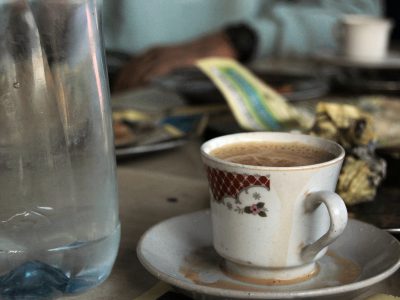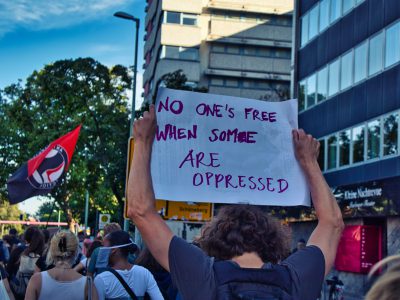WP_Post Object
(
[ID] => 2522
[post_author] => 2
[post_date] => 2021-04-24 15:35:11
[post_date_gmt] => 2021-04-24 15:35:11
[post_content] => The devastating legacy of the Bosnian War is laid bare in this dramatization of the Srebrenica massacre.
I don’t know if I have seen Quo Vadis, Aida? I know I have sat in front of a screen on four or five separate occasions and taken in portions of the film. But I don’t know whether I have “seen” the film in the way that term is typically used. It is perhaps more accurate to say that I have experienced Aida, or more truthfully still: Aida played, and I was swallowed by grief.
Quo Vadis, Aida? is the Academy Award nominated film by Sarajevo-born director Jasmila Žbanić. It documents the fall of Srebrenica, a town in eastern Bosnia and Herzegovina (BiH), in July 1995 to the Serb nationalist forces led by convicted war criminal Ratko Mladić. The ensuing campaign of extermination—which took place between July 11 and July 22— saw the murder of 8,372 Bosniak (Bosnian Muslim) men and boys and the expulsion of the entire non-Serb population of the town (approximately 25,000 people, primarily women and girls).
Aida is a (barely) fictionalized account of the events that occurred in Srebrenica; it focuses on the protagonist Aida Selmanagić (Jasna Đuričić), a local schoolteacher who has obtained wartime work as a UN translator, and her increasingly untenable position as an intermediary between the incompetent Dutch peacekeepers and the frantic, besieged Bosniak population of the town. The plot is largely based on the real-life experiences of Hasan Nuhanović, as told in his 2007 book Under the UN Flag, but draws thematically on the broader Srebrenica survivors’ literature.
But the Srebrenica Genocide—officially recognized as such by the International Criminal Tribunal— is only the final, horrific culmination of what scholars, researchers, and survivors refer to as the Bosnian Genocide. That is the systematic campaign of extermination, expulsions, torture, and sexual violence carried out in BiH by the Army of the Republika Srpska (VRS) between 1992 and 1995. The genocide targeted primarily the country’s Bosniak community; it was directed by the leadership of the self-declared Republika Srpska (RS) and financed and supplied by their patrons in the Serbian government.
In the film, as the townspeople begin to realize that the UN and the wider international community could not or would not halt the VRS conquest of Srebrenica, panic and terror ensues. Thousands rush to the UN base, trying to find shelter and safety there, while thousands more are forced to wait outside the overcrowded facility, with no shelter or food, as they await their fate. Aida races around the base, forced to translate the lies of the Dutch officers as they instruct the Bosniaks to prepare for evacuation to a “safe place.” Aida knows the truth—that Mladić’s forces are loading the men onto trucks and taking them to be killed. She first tries to hide her teenage sons and husband in obscure corners of the base, which is a repurposed abandoned factory, while she pleads repeatedly, desperately (and ultimately vainly) with her UN employers to ensure their safe passage.
Žbanić insists that, like the UN peacekeepers in Srebrenica, her audience knows what is happening—that it is genocide, and that we are responsible for bearing witness. Twice we see a Dutch junior officer who wears a Star of David pendant observe his superiors equivocate on Aida’s anguished pleas for help. His disgust with his commanders is evident. But for Bosnian viewers there is an added level of poignancy in this obvious reference to the world’s inaction during the Holocaust.
[caption id="attachment_2526" align="aligncenter" width="840"] A still from the film shows Bosniaks taking refuge at the UN Dutch peacekeeper base in Srebrenica.[/caption]
In 1993, at the dedication of the U.S. Holocaust Museum, Elie Wiesel made an impassioned plea to President Clinton, seated only a few paces behind him, to intervene in the conflict: “Mr. President, I cannot NOT tell you something. I have been in the former Yugoslavia, last fall. I cannot sleep since— what I have seen. As a Jew I am saying this, we must do something to stop the bloodshed in that country…Something, anything must be done.”
Nor was Wiesel alone in his testimony. America’s Jewish community was at the forefront of the international effort to demand a credible response to the Bosnian Genocide. In Aida, Žbanić is the one bearing witness to those who saw what was happening in BiH and called it by its proper name.
The film is harrowing. It is an emotional ordeal to sit through for anyone. But for those from BiH, especially for those who have any direct experience or memory of the war, it is almost unbearable. This is also the film’s greatest triumph: it is a story about the Bosnian Genocide, told by Bosnians, for Bosnian audiences. That it has, rightly, won international acclaim is hugely significant, but Žbanić’s crowning achievement is in refusing to tell this story for anyone other than the Bosnian and Bosniak people themselves.
One aspect of that commitment is seen in the director’s remarkable talent for capturing the authenticity of the Bosnian people; their affect, their cadence —how our language sounds when it is whispered. Especially when it is whispered by our mothers; whispered when they, alone, were left to tell us that it would all work out, that we were safe. Knowing that it was not true.
For this Bosnian the film felt almost nauseating in its intimacy. One scarcely experiences the production as a piece of media at all. It took me nearly a week to watch the whole thing, because I could not manage more than twenty or so minutes at a time. My breathing would quicken, verging on hyperventilating; I would realize only after the fact I had been digging my fingers into my thighs, rocking in place.
Such reactions are, obviously, manifestations of being forced to relive trauma. But this too is a testament to the singularity of the work. Because the truth is that Bosnian and Srebrenica Genocide denial is perhaps more rampant today than at any time since the events themselves occurred.
In Serbia, and the RS entity in post-war BiH, denial and negationism are official government policy. Across the territory of the latter, including Srebrenica, returnees are routinely harassed, their properties, community centers, and places of worship defaced. Bosniak children are prevented from referring to and studying the Bosnian language, or learning the history of the genocide. The government in the de facto capital of the entity, Banja Luka, has spent hundreds of thousands of dollars, if not millions, over the last two decades sponsoring the publication of a series of revisionist and negationist accounts of the Bosnian Genocide. Worse, its leadership, headed by Milorad Dodik, is explicitly attempting to engineer the entity’s secession from BiH, and thus the belated realization of a “Greater Serbia” that caused the dissolution of Yugoslavia and the Bosnian War in the first place.
Much as in the 1990s, the international response to all of this is muted at best. Indeed, the very existence of the RS—a product of the U.S.-brokered Dayton Peace Accords in 1995 —is an affront to the survivors of the genocide. As the war-time leadership of the RS acknowledged openly, the sole purpose of its creation was the extermination and expulsion of the Bosniak and non-Serb populations of northwestern and eastern BiH. Even the entity’s name speaks to this; it is a grammatically bizarre construction which does not easily translate to English and barely makes sense in our language. In Western media it’s often incorrectly glossed as “Serb Republic.” In terms of its intended meaning, it is perhaps more accurate to refer to it as “Serbland.” But the result is the same: it is a chauvinist term, meant to erase non-Serbs from the area’s politics, society, and history.
In this sense, the events portrayed in Aida are not history, per se. They occurred in the past, yes, but the politics that caused the horror in Srebrenica, which caused the Bosnian War, remain active and unchanged. No one who has even a passing familiarity with the daily stream of vulgar, sectarian chauvinism emanating from the ruling regimes in Belgrade and Banja Luka could seriously believe that these reactionaries regret the genocide. Or that they would pass up an opportunity to recreate the horrors of Srebrenica— or any of Bosnia’s dozens of other killing fields. One need only recall the warning issued to NATO forces by Serbia’s now President Aleksandar Vučić in the Serbian parliament on July 20, 1995, as the executions in Srebrenica were still ongoing: “Kill one Serb, and we’ll kill a hundred Muslims.”
Today Mr. Vučić presides over a one-party regime in Serbia, just like his mentor Slobodan Milošević. The regime hands out free copies of genocide denial literature to those seeking COVID-19 vaccines. BiH’s friends in Europe, meanwhile, award Nobel Prizes and seats in the House of Lords to genocide deniers like Peter Handke and Claire Fox—that is, when their governments are not busy proposing the country’s partition and dissolution.
The international community watched in real time as the killings in Srebrenica unfolded. They expended more energy trying to wash their hands of any sort of meaningful involvement in the Bosnian War, than they did on implementing the idea of humanitarian intervention. When such action finally came, it only took the deaths of fewer than 30 VRS soldiers for the genocidal regime to concede to negotiations. But by that point, nearly 100,000 other Bosnians had been killed— most of them civilians. The vast majority were Bosniaks, targeted systematically for extermination by the VRS.
Regardless of whether Quo Vadis, Aida? wins the Oscar for best foreign film, Žbanić’s work has already cemented, in searing detail, the truth of the genocide in Srebrenica and BiH. For as determined as the forces of negation and revision are, her work has projected the memory of that terrible crime to the world.
But should she win, Bosnians will weep again—this time, tears of catharsis. Our story, and our survival, will finally be seen and recognized on its own terms.
[post_title] => Bearing witness to genocide: 'Quo Vadis, Aida?' is a shattering, essential film
[post_excerpt] => Director Jasmila Žbanić dramatizes the events surrounding the Srebrenica massacre of July 1995, when Serb nationalist forces, led by convicted war criminal Ratko Mladic, murdered more than 8,000 Bosniaks, mostly men and boys.
[post_status] => publish
[comment_status] => closed
[ping_status] => open
[post_password] =>
[post_name] => bearing-witness-to-genocide-quo-vadis-aida-is-a-shattering-essential-film
[to_ping] =>
[pinged] =>
[post_modified] => 2024-08-28 21:15:13
[post_modified_gmt] => 2024-08-28 21:15:13
[post_content_filtered] =>
[post_parent] => 0
[guid] => https://conversationalist.org/?p=2522
[menu_order] => 211
[post_type] => post
[post_mime_type] =>
[comment_count] => 0
[filter] => raw
)
A still from the film shows Bosniaks taking refuge at the UN Dutch peacekeeper base in Srebrenica.[/caption]
In 1993, at the dedication of the U.S. Holocaust Museum, Elie Wiesel made an impassioned plea to President Clinton, seated only a few paces behind him, to intervene in the conflict: “Mr. President, I cannot NOT tell you something. I have been in the former Yugoslavia, last fall. I cannot sleep since— what I have seen. As a Jew I am saying this, we must do something to stop the bloodshed in that country…Something, anything must be done.”
Nor was Wiesel alone in his testimony. America’s Jewish community was at the forefront of the international effort to demand a credible response to the Bosnian Genocide. In Aida, Žbanić is the one bearing witness to those who saw what was happening in BiH and called it by its proper name.
The film is harrowing. It is an emotional ordeal to sit through for anyone. But for those from BiH, especially for those who have any direct experience or memory of the war, it is almost unbearable. This is also the film’s greatest triumph: it is a story about the Bosnian Genocide, told by Bosnians, for Bosnian audiences. That it has, rightly, won international acclaim is hugely significant, but Žbanić’s crowning achievement is in refusing to tell this story for anyone other than the Bosnian and Bosniak people themselves.
One aspect of that commitment is seen in the director’s remarkable talent for capturing the authenticity of the Bosnian people; their affect, their cadence —how our language sounds when it is whispered. Especially when it is whispered by our mothers; whispered when they, alone, were left to tell us that it would all work out, that we were safe. Knowing that it was not true.
For this Bosnian the film felt almost nauseating in its intimacy. One scarcely experiences the production as a piece of media at all. It took me nearly a week to watch the whole thing, because I could not manage more than twenty or so minutes at a time. My breathing would quicken, verging on hyperventilating; I would realize only after the fact I had been digging my fingers into my thighs, rocking in place.
Such reactions are, obviously, manifestations of being forced to relive trauma. But this too is a testament to the singularity of the work. Because the truth is that Bosnian and Srebrenica Genocide denial is perhaps more rampant today than at any time since the events themselves occurred.
In Serbia, and the RS entity in post-war BiH, denial and negationism are official government policy. Across the territory of the latter, including Srebrenica, returnees are routinely harassed, their properties, community centers, and places of worship defaced. Bosniak children are prevented from referring to and studying the Bosnian language, or learning the history of the genocide. The government in the de facto capital of the entity, Banja Luka, has spent hundreds of thousands of dollars, if not millions, over the last two decades sponsoring the publication of a series of revisionist and negationist accounts of the Bosnian Genocide. Worse, its leadership, headed by Milorad Dodik, is explicitly attempting to engineer the entity’s secession from BiH, and thus the belated realization of a “Greater Serbia” that caused the dissolution of Yugoslavia and the Bosnian War in the first place.
Much as in the 1990s, the international response to all of this is muted at best. Indeed, the very existence of the RS—a product of the U.S.-brokered Dayton Peace Accords in 1995 —is an affront to the survivors of the genocide. As the war-time leadership of the RS acknowledged openly, the sole purpose of its creation was the extermination and expulsion of the Bosniak and non-Serb populations of northwestern and eastern BiH. Even the entity’s name speaks to this; it is a grammatically bizarre construction which does not easily translate to English and barely makes sense in our language. In Western media it’s often incorrectly glossed as “Serb Republic.” In terms of its intended meaning, it is perhaps more accurate to refer to it as “Serbland.” But the result is the same: it is a chauvinist term, meant to erase non-Serbs from the area’s politics, society, and history.
In this sense, the events portrayed in Aida are not history, per se. They occurred in the past, yes, but the politics that caused the horror in Srebrenica, which caused the Bosnian War, remain active and unchanged. No one who has even a passing familiarity with the daily stream of vulgar, sectarian chauvinism emanating from the ruling regimes in Belgrade and Banja Luka could seriously believe that these reactionaries regret the genocide. Or that they would pass up an opportunity to recreate the horrors of Srebrenica— or any of Bosnia’s dozens of other killing fields. One need only recall the warning issued to NATO forces by Serbia’s now President Aleksandar Vučić in the Serbian parliament on July 20, 1995, as the executions in Srebrenica were still ongoing: “Kill one Serb, and we’ll kill a hundred Muslims.”
Today Mr. Vučić presides over a one-party regime in Serbia, just like his mentor Slobodan Milošević. The regime hands out free copies of genocide denial literature to those seeking COVID-19 vaccines. BiH’s friends in Europe, meanwhile, award Nobel Prizes and seats in the House of Lords to genocide deniers like Peter Handke and Claire Fox—that is, when their governments are not busy proposing the country’s partition and dissolution.
The international community watched in real time as the killings in Srebrenica unfolded. They expended more energy trying to wash their hands of any sort of meaningful involvement in the Bosnian War, than they did on implementing the idea of humanitarian intervention. When such action finally came, it only took the deaths of fewer than 30 VRS soldiers for the genocidal regime to concede to negotiations. But by that point, nearly 100,000 other Bosnians had been killed— most of them civilians. The vast majority were Bosniaks, targeted systematically for extermination by the VRS.
Regardless of whether Quo Vadis, Aida? wins the Oscar for best foreign film, Žbanić’s work has already cemented, in searing detail, the truth of the genocide in Srebrenica and BiH. For as determined as the forces of negation and revision are, her work has projected the memory of that terrible crime to the world.
But should she win, Bosnians will weep again—this time, tears of catharsis. Our story, and our survival, will finally be seen and recognized on its own terms.
[post_title] => Bearing witness to genocide: 'Quo Vadis, Aida?' is a shattering, essential film
[post_excerpt] => Director Jasmila Žbanić dramatizes the events surrounding the Srebrenica massacre of July 1995, when Serb nationalist forces, led by convicted war criminal Ratko Mladic, murdered more than 8,000 Bosniaks, mostly men and boys.
[post_status] => publish
[comment_status] => closed
[ping_status] => open
[post_password] =>
[post_name] => bearing-witness-to-genocide-quo-vadis-aida-is-a-shattering-essential-film
[to_ping] =>
[pinged] =>
[post_modified] => 2024-08-28 21:15:13
[post_modified_gmt] => 2024-08-28 21:15:13
[post_content_filtered] =>
[post_parent] => 0
[guid] => https://conversationalist.org/?p=2522
[menu_order] => 211
[post_type] => post
[post_mime_type] =>
[comment_count] => 0
[filter] => raw
)


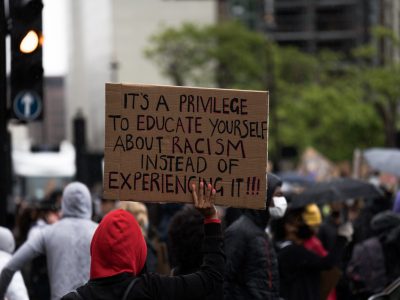

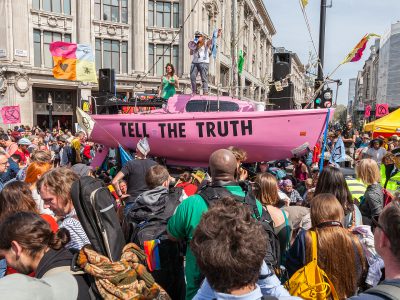
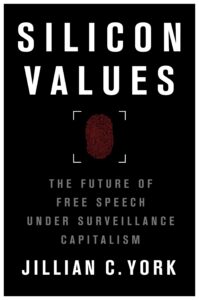 During the decade prior to the 2011 uprising, Egypt saw a blogging boom, with people from diverse socio-economic backgrounds writing outspoken commentary about social and political issues, even though they ran the risk of arrest and imprisonment for criticizing the state. The internet provided space for discussions that had previously been restricted to private gatherings; it also enabled cross-national dialogue throughout the region, between bloggers who shared a common language. Public protests weren’t unheard of—in fact, as those I interviewed for the book argued, they had been building up slowly over time—but they were sporadic and lacked mass support.
While some bloggers and social media users chose to publish under their own names, others were justifiably concerned for their safety. And so, the creators of “We Are All Khaled Saeed” chose to manage the Facebook page using pseudonyms.
Facebook, however, has always had a policy that forbids the use of “fake names,” predicated on the misguided belief that people behave with more civility when using their “real” identity. Mark Zuckerberg famously claimed that having more than one identity represents a lack of integrity, thus demonstrating a profound lack of imagination and considerable ignorance. Not only had Zuckerberg never considered why a person of integrity who lived in an oppressive authoritarian state might fear revealing their identity, but he had clearly never explored the rich history of anonymous and pseudonymous publishing.
In November 2010, just before Egypt’s parliamentary elections and a planned anti-regime demonstration, Facebook, acting on a tip that its owners were using fake names, removed the “We are all Khaled Saeed” page.
At this point I had been writing and communicating for some time with Facebook staff about the problematic nature of the policy banning anonymous users. It was Thanksgiving weekend in the U.S., where I lived at the time, but a group of activists scrambled to contact Facebook to see if there was anything they could do. To their credit, the company offered a creative solution: If the Egyptian activists could find an administrator who was willing to use their real name, the page would be restored.
They did so, and the page went on to call for what became the January 25 revolution.
A few months later, I joined the Electronic Frontier Foundation and began to work full-time in advocacy, which gave my criticisms more weight and enabled me to communicate more directly with policymakers at various tech companies.
Three years later, while driving across the United States with my mother and writing a piece about social media and the Egyptian revolution, I turned on the hotel television one night and saw on the news that police in Ferguson, Missouri had shot an 18-year-old Black man, Michael Brown, sparking protests that drew a disproportionate militarized response.
The parallels between Egypt and the United States struck me even then, but only in 2016 did I become fully aware. That summer, a police officer in Minnesota pulled over 32-year-old Philando Castile—a Black man—at a traffic stop and, as he reached for his license and registration, fatally shot him five times at close range.
Castile’s partner, Diamond Reynolds, was in the passenger’s seat and had the presence of mind to whip out her phone in the immediate aftermath, streaming her exchange with the police officer on Facebook Live.
Almost immediately, Facebook removed the video. The company later restored it, citing a “technical glitch,” but the incident demonstrated the power that technology companies—accountable to no one but their shareholders and driven by profit motives—have over our expression.
The internet brought about a fundamental shift in the way we communicate and relate to one another, but its commercialization has laid bare the limits of existing systems of governance. In the years following these incidents, content moderation and the systems surrounding it became almost a singular obsession. I worked to document the experiences of social media users, collaborated with numerous individuals, and learned about the structural limitations to changing the system.
Over the years, my views on the relationship between free speech and tech have evolved. Once I believed that companies should play no role in governing our speech, but later I shifted to pragmatism, seeking ways to mitigate the harm of their decisions and enforce limits on their power.
But while the parameters of the problem and its potential solutions grew clearer, so did my thesis: Content moderation— specifically, the uneven enforcement of already-inconsistent policies—disproportionately impacts marginalized communities and exacerbates existing structural power balances. Offline repression is, as it turns out, replicated online.
The 2016 election of Donald Trump to the U.S. presidency brought the issue of content moderation to the fore; suddenly, the terms of the debate shifted. Conservatives in the United States claimed they were unjustly singled out by Big Tech and the media amplified those claims—much to my chagrin, since they were not borne out by data. At the same time, the rise of right-wing extremism, disinformation, and harassment—such as the spread of the QAnon conspiracy and wildly inaccurate information about vaccines—on social media led me to doubt some of my earlier conclusions about the role Big Tech should play in governing speech.
That’s when I knew that it was time to write about content moderation’s less-debated harms and to document them in a book.
Setting out to write about a subject I know so intimately (and have even experienced firsthand), I thought I knew what I would say. But the process turned out to be a learning experience that caused me to rethink some of my own assumptions about the right way forward.
One of the final interviews I conducted for the book was with Dave Willner, one of the early policy architects at Facebook. Sitting at a café in San Francisco just a few months before the pandemic hit, he told me: “Social media empowers previously marginal people, and some of those previously marginal people are trans teenagers and some are neo-Nazis. The empowerment sense is the same, and some of it we think is good and some of it we think is not good. The coming together of people with rare problems or views is agnostic.”
That framing guided me in the final months of writing. My instinct, based on those early experiences with social media as a democratizing force, has always been to think about the unintended consequences of any policy for the world’s most vulnerable users, and it is that lens that guides my passion for protecting free expression. But I also see now that it is imperative never to forget a crucial fact—that the very same tools which have empowered historically marginalized communities can also enable their oppressors.
[post_title] => Between Nazis and democracy activists: social media and the free speech dilemma
[post_excerpt] => The content moderation policies employed by social media platforms disproportionately affect marginalized communities and exacerbate power imbalances. Offline repression is replicated online.
[post_status] => publish
[comment_status] => closed
[ping_status] => open
[post_password] =>
[post_name] => between-nazis-and-democracy-activists-social-media-and-the-free-speech-dilemma
[to_ping] =>
[pinged] =>
[post_modified] => 2024-08-28 21:15:13
[post_modified_gmt] => 2024-08-28 21:15:13
[post_content_filtered] =>
[post_parent] => 0
[guid] => https://conversationalist.org/?p=2452
[menu_order] => 216
[post_type] => post
[post_mime_type] =>
[comment_count] => 0
[filter] => raw
)
During the decade prior to the 2011 uprising, Egypt saw a blogging boom, with people from diverse socio-economic backgrounds writing outspoken commentary about social and political issues, even though they ran the risk of arrest and imprisonment for criticizing the state. The internet provided space for discussions that had previously been restricted to private gatherings; it also enabled cross-national dialogue throughout the region, between bloggers who shared a common language. Public protests weren’t unheard of—in fact, as those I interviewed for the book argued, they had been building up slowly over time—but they were sporadic and lacked mass support.
While some bloggers and social media users chose to publish under their own names, others were justifiably concerned for their safety. And so, the creators of “We Are All Khaled Saeed” chose to manage the Facebook page using pseudonyms.
Facebook, however, has always had a policy that forbids the use of “fake names,” predicated on the misguided belief that people behave with more civility when using their “real” identity. Mark Zuckerberg famously claimed that having more than one identity represents a lack of integrity, thus demonstrating a profound lack of imagination and considerable ignorance. Not only had Zuckerberg never considered why a person of integrity who lived in an oppressive authoritarian state might fear revealing their identity, but he had clearly never explored the rich history of anonymous and pseudonymous publishing.
In November 2010, just before Egypt’s parliamentary elections and a planned anti-regime demonstration, Facebook, acting on a tip that its owners were using fake names, removed the “We are all Khaled Saeed” page.
At this point I had been writing and communicating for some time with Facebook staff about the problematic nature of the policy banning anonymous users. It was Thanksgiving weekend in the U.S., where I lived at the time, but a group of activists scrambled to contact Facebook to see if there was anything they could do. To their credit, the company offered a creative solution: If the Egyptian activists could find an administrator who was willing to use their real name, the page would be restored.
They did so, and the page went on to call for what became the January 25 revolution.
A few months later, I joined the Electronic Frontier Foundation and began to work full-time in advocacy, which gave my criticisms more weight and enabled me to communicate more directly with policymakers at various tech companies.
Three years later, while driving across the United States with my mother and writing a piece about social media and the Egyptian revolution, I turned on the hotel television one night and saw on the news that police in Ferguson, Missouri had shot an 18-year-old Black man, Michael Brown, sparking protests that drew a disproportionate militarized response.
The parallels between Egypt and the United States struck me even then, but only in 2016 did I become fully aware. That summer, a police officer in Minnesota pulled over 32-year-old Philando Castile—a Black man—at a traffic stop and, as he reached for his license and registration, fatally shot him five times at close range.
Castile’s partner, Diamond Reynolds, was in the passenger’s seat and had the presence of mind to whip out her phone in the immediate aftermath, streaming her exchange with the police officer on Facebook Live.
Almost immediately, Facebook removed the video. The company later restored it, citing a “technical glitch,” but the incident demonstrated the power that technology companies—accountable to no one but their shareholders and driven by profit motives—have over our expression.
The internet brought about a fundamental shift in the way we communicate and relate to one another, but its commercialization has laid bare the limits of existing systems of governance. In the years following these incidents, content moderation and the systems surrounding it became almost a singular obsession. I worked to document the experiences of social media users, collaborated with numerous individuals, and learned about the structural limitations to changing the system.
Over the years, my views on the relationship between free speech and tech have evolved. Once I believed that companies should play no role in governing our speech, but later I shifted to pragmatism, seeking ways to mitigate the harm of their decisions and enforce limits on their power.
But while the parameters of the problem and its potential solutions grew clearer, so did my thesis: Content moderation— specifically, the uneven enforcement of already-inconsistent policies—disproportionately impacts marginalized communities and exacerbates existing structural power balances. Offline repression is, as it turns out, replicated online.
The 2016 election of Donald Trump to the U.S. presidency brought the issue of content moderation to the fore; suddenly, the terms of the debate shifted. Conservatives in the United States claimed they were unjustly singled out by Big Tech and the media amplified those claims—much to my chagrin, since they were not borne out by data. At the same time, the rise of right-wing extremism, disinformation, and harassment—such as the spread of the QAnon conspiracy and wildly inaccurate information about vaccines—on social media led me to doubt some of my earlier conclusions about the role Big Tech should play in governing speech.
That’s when I knew that it was time to write about content moderation’s less-debated harms and to document them in a book.
Setting out to write about a subject I know so intimately (and have even experienced firsthand), I thought I knew what I would say. But the process turned out to be a learning experience that caused me to rethink some of my own assumptions about the right way forward.
One of the final interviews I conducted for the book was with Dave Willner, one of the early policy architects at Facebook. Sitting at a café in San Francisco just a few months before the pandemic hit, he told me: “Social media empowers previously marginal people, and some of those previously marginal people are trans teenagers and some are neo-Nazis. The empowerment sense is the same, and some of it we think is good and some of it we think is not good. The coming together of people with rare problems or views is agnostic.”
That framing guided me in the final months of writing. My instinct, based on those early experiences with social media as a democratizing force, has always been to think about the unintended consequences of any policy for the world’s most vulnerable users, and it is that lens that guides my passion for protecting free expression. But I also see now that it is imperative never to forget a crucial fact—that the very same tools which have empowered historically marginalized communities can also enable their oppressors.
[post_title] => Between Nazis and democracy activists: social media and the free speech dilemma
[post_excerpt] => The content moderation policies employed by social media platforms disproportionately affect marginalized communities and exacerbate power imbalances. Offline repression is replicated online.
[post_status] => publish
[comment_status] => closed
[ping_status] => open
[post_password] =>
[post_name] => between-nazis-and-democracy-activists-social-media-and-the-free-speech-dilemma
[to_ping] =>
[pinged] =>
[post_modified] => 2024-08-28 21:15:13
[post_modified_gmt] => 2024-08-28 21:15:13
[post_content_filtered] =>
[post_parent] => 0
[guid] => https://conversationalist.org/?p=2452
[menu_order] => 216
[post_type] => post
[post_mime_type] =>
[comment_count] => 0
[filter] => raw
)
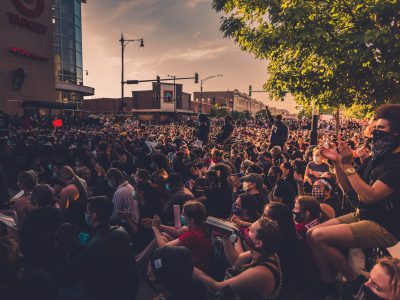
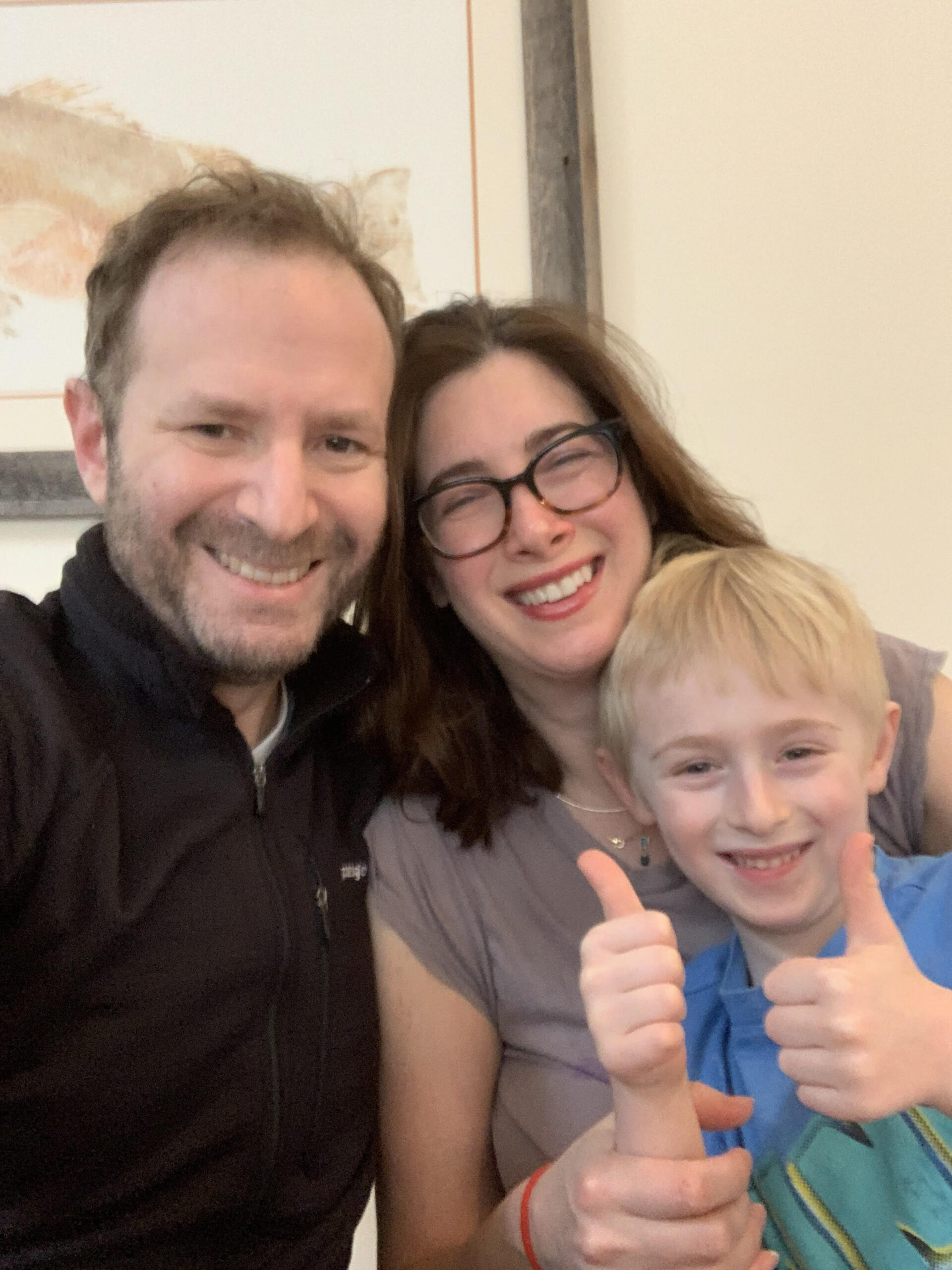 Rachel Dodes with her husband and son.[/caption]
Rachel Dodes with her husband and son.[/caption]


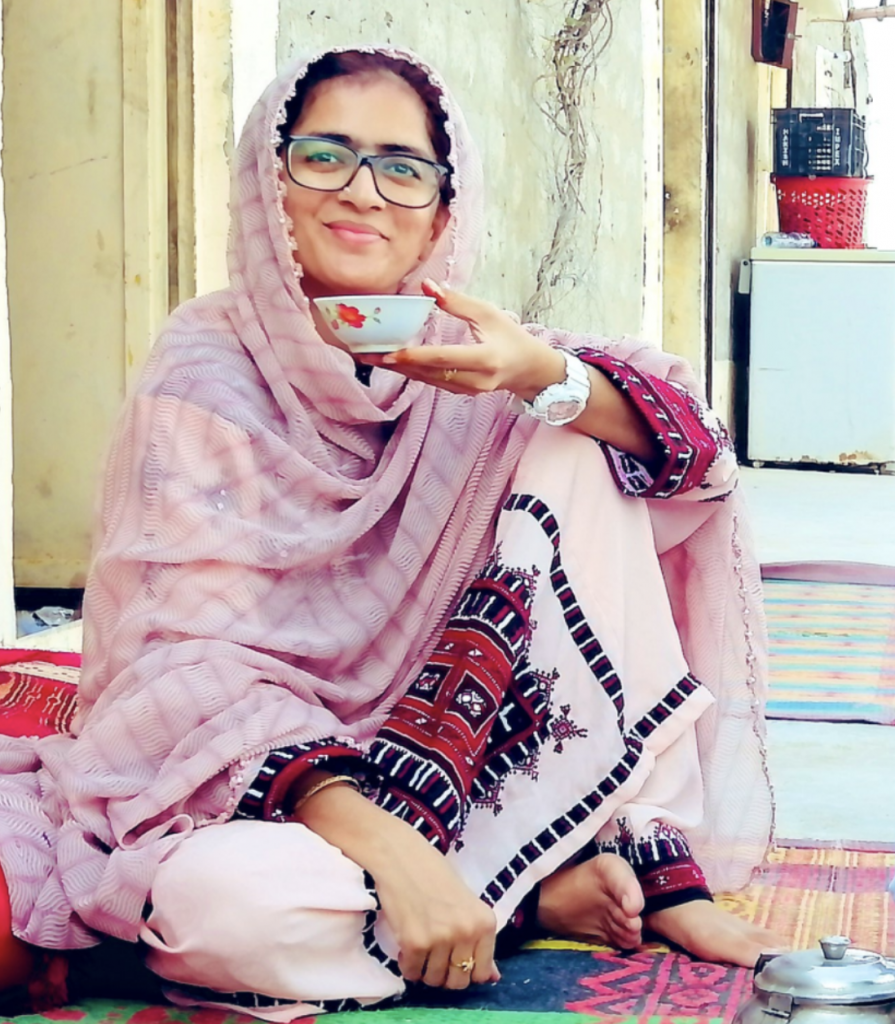 Granaz Baloch[/caption]
Granaz Baloch[/caption]
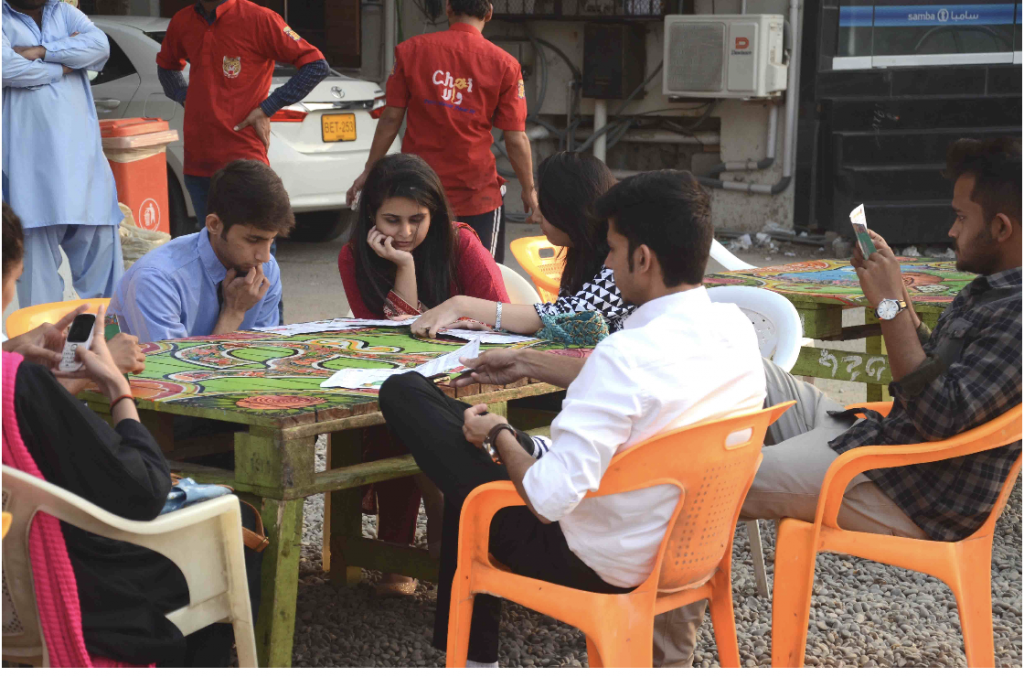 The scene at Chai Wala.[/caption]
The scene at Chai Wala.[/caption]
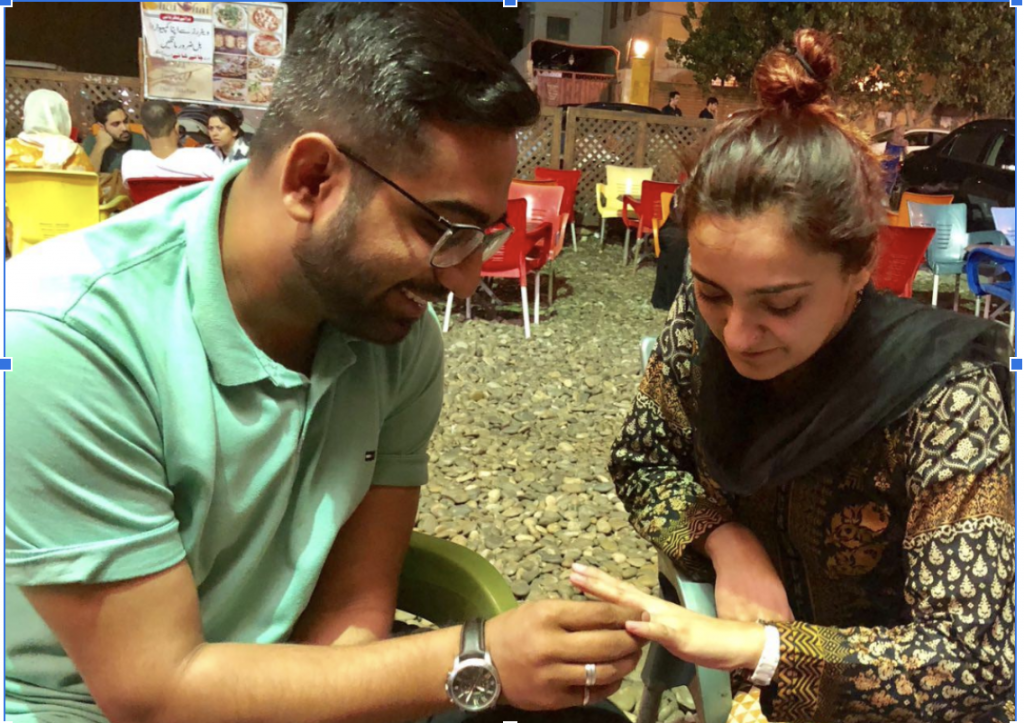 Shaheera Anwar getting engaged at a traditional dhaba in Karachi.[/caption]
Shaheera Anwar getting engaged at a traditional dhaba in Karachi.[/caption]
